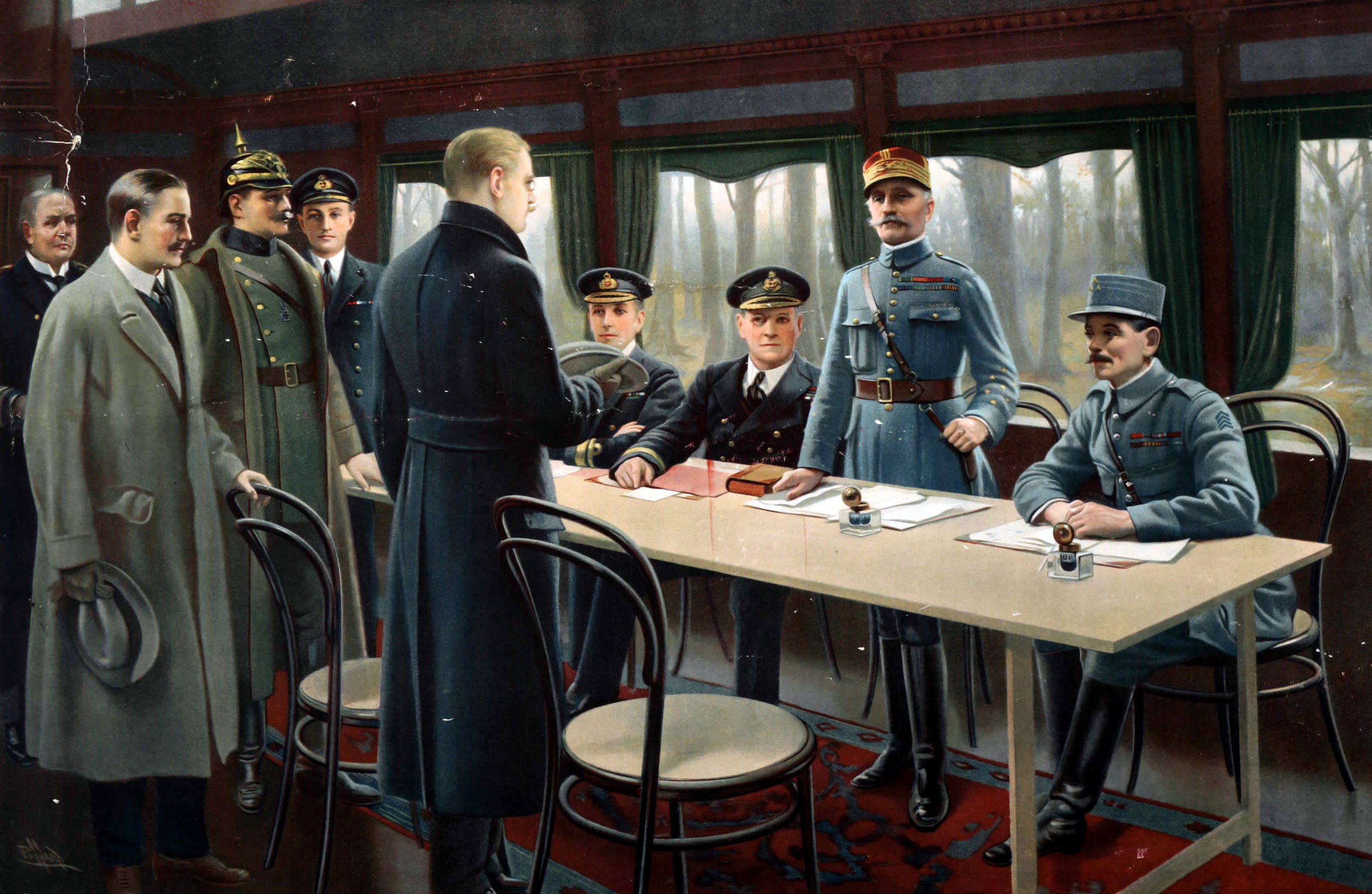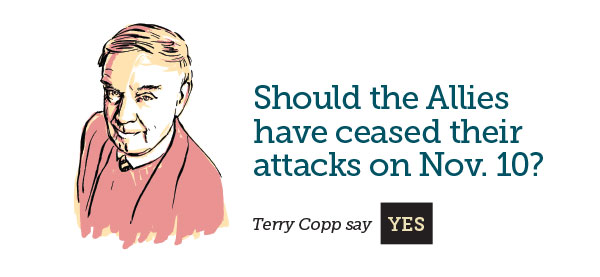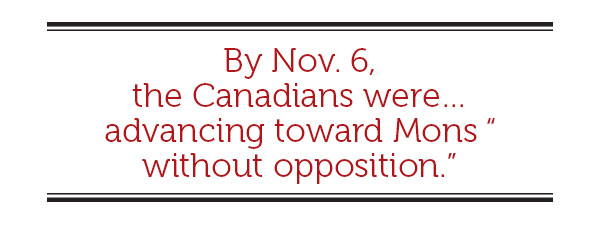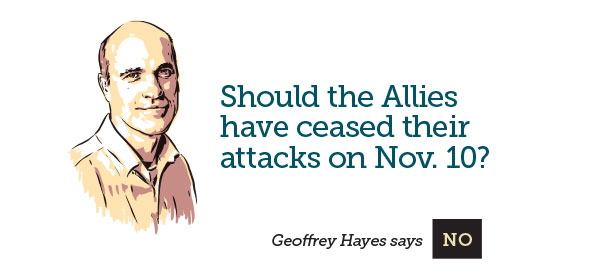

On Sept. 28, 1918, General Erich Ludendorff, commander of the German army, admitted that the war was lost. “If we had the strength to reverse the situation in the West, then of course nothing would yet have been lost,” he stated. “But we had no means for that.… We had to count on being beaten back again and again.”
Insisting that “every hour of delay is dangerous,” Ludendorff led an effort to create a new German government and issue an immediate call for an end to the fighting. A new chancellor, Prince Maximilian of Baden, was appointed on Oct. 4, and claiming that he wished “to avoid further bloodshed,” asked American President Woodrow Wilson for an immediate armistice.
Wilson’s reply on Oct. 8 demanded the immediate “withdrawal of their forces everywhere from invaded territory.” On Oct. 12, the Germans agreed to evacuate occupied territory, but with an international commission supervising the process. This delaying tactic was rejected by Wilson.
The small coterie of decision-makers in Germany remained divided and uncertain. Ludendorff wanted to avoid responsibility for a military surrender while Rupprecht, Crown Prince of Bavaria, warned that “we must obtain peace before the enemy breaks through into Germany.”
On Oct. 26, the Turkish government sent envoys to sign a separate peace. The Austrian emperor soon followed. On Nov. 5, French Marshal Ferdinand Foch was authorized to “receive representatives of the German government and communicate to them the terms of the armistice.” The terms were presented on Nov. 8 in a railway carriage in Forêt de Compiègne, northeast of Paris. The German delegates were given 72 hours—until 11 a.m. on Nov. 11—to sign the armistice.

The prolonged armistice negotiations had little impact on Allied military operations, raising the age-old question of the legitimacy or wisdom of continuing combat when the war is all but won.
The issue became particularly important to Canadians after Lieutenant-General Sir Arthur Currie was criticized for the unnecessary deaths of Canadian soldiers in the final hours of the war. Rumours, innuendo and specific attacks on his reputation by Sir Sam Hughes, during and after the war, culminated in an infamous 1928 libel trial in Port Hope, Ont., where Currie defended his reputation and won vindication, but doubts about his actions continue to this day.
After the capture of Valenciennes on Nov. 3, Currie’s orders from Britain’s First Army were to “act vigorously…so as to keep the Germans from establishing a new line.” By Nov. 6, the Canadians were across the French border into Belgium, advancing toward Mons “without opposition.”
On the evening of Nov. 9, Currie had a clear choice: wait 36 hours to see if the Germans accepted the terms or order the capture of Mons. He decided “the capture of Mons should close the fighting records of the Canadian troops” and ordered the advance. The cost to Canada—18 officers and 262 other ranks killed, wounded or missing in the last two days of the war—was tragic and unnecessary.

Should the fighting to end the First World War in western Europe have ended before the armistice of Nov. 11, 1918? Those who thought so at the time have helped nurture a view of the war that grew increasingly popular in the 1960s: ruthless donkeys sacrificing still more young lions in the war’s final hours for dubious gains.
The topic quickly became political in the war’s aftermath. American Republicans eagerly grilled General John Pershing and his staff about American deaths in the final days to score points against Woodrow Wilson’s Democrats. The battles were less partisan in Canada, but equally nasty.
In March 1919, Sam Hughes, the former Minister of Militia and Defence, accused Lieutenant-General Arthur Currie, the Canadian Corps commander, of wasting lives by pressing attacks into Mons on the morning of Nov. 11. These men, Hughes maintained, had died for a mere symbol: the British had retreated from Mons back in 1914.
Hughes, eager for revenge against Currie, died in 1921 protected by parliamentary privilege. But when a newspaper in Port Hope, Ont., repeated Hughes’s charges in 1927, Currie sued for libel. Currie won the decision, but the strain likely contributed to his early death in 1933.

Postwar politics and the benefit of hindsight make these last deaths especially tragic. But we should recall that at the start of 1918, the Germans were on the brink of winning the war. Having defeated Russia, Germany had little interest in negotiating a peace based on American president’s Woodrow Wilson’s 14 Points. It wanted a military victory. Massive German attacks in the spring drove deep wedges between the British and French forces. The Germans captured thousands of prisoners and effectively destroyed the British Fifth Army. Paris came under German gunfire. It was a very near-run thing.
The momentum shifted in the summer, when General Foch led a sequence of counterstrokes to drive the Germans out of France and Belgium. The German high command stubbornly refused to see the inevitable. On Oct. 4, with dissent in Germany threatening the Kaiser and the army, and with their allies collapsing around them, the German generals finally reached out to the Americans to end the fighting based on the 14 Points.
The Germans tried to exploit Allied suspicions of one another and buy time. But German actions could still shock. On Oct. 8, the Canadians found the French city of Cambrai in flames—Germans had burned it on their retreat. Two days later, a German U-boat sunk the British liner RMS Leinster at a cost of nearly 500 lives. The British (and Canadians) still faced difficult fighting. Rumours of an approaching ceasefire could not counteract orders. The end took everyone by surprise.
Only in hindsight and under the glare of political partisanship can those final deaths be deemed fruitless. Those lads who died on Nov. 11, 1918, should be remembered among the half million casualties suffered in the war’s final weeks as the German generals scrambled to avoid responsibility for a war they nearly won, but ultimately lost.
TERRY COPP is director emeritus of the Laurier Centre for Military and Strategic Disarmament Studies at Wilfrid Laurier University. He is the author of numerous books and articles on Canada’s role in the two world wars.
GEOFFREY HAYES is an associate professor of history at the University of Waterloo. His focus is Canadian military history, peacekeeping, Afghanistan and Canadian military leadership. He is also on the board of directors of the Canadian Battlefields Foundation.
Advertisement










